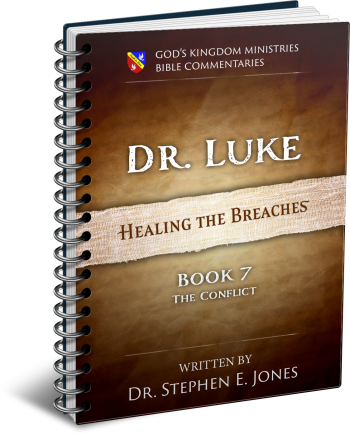Latest Posts
View the latest posts in an easy-to-read list format, with filtering options.

This is a commentary on Luke 18:31 to 21:38 Describing Jesus's trip to Jerusalem and the conflict with the Chief Priest leading to His Crucifixion.
Category - Bible Commentaries

In Luke 21:7-9 Jesus began to answer the disciples’ question about the timing of the temple’s destruction. The first answer Jesus gave was about men claiming to be the Christ. Then in verse 10 there is a short break in the narrative, separating the first part from the rest of Jesus’ answer. Luke 21:10, 11 continues,
10 Then He continued by saying to them, “Nation will rise against nation, and kingdom against kingdom, 11 and there will be great earthquakes, and in various places plagues and famines; and there will be terrors and great signs from heaven.”
There were wars during the years between Christ’s crucifixion and the destruction of Jerusalem, but this is not unusual. The larger the empire, the more it must fight to keep its position of power. In the first century, Rome and Parthia were the dominant powers to watch, as these were the two superpowers of the day.
The main wars during that 40-year time frame was fought between Rome and Britain. Rome invaded Britain in 43, turning parts of it into communities for retired soldiers. Hostilities broke out again in 52, and the British royal family was taken to Rome as captives, including Gladys and Linus, the children of Caractacus (or Caradoc).
They had already become Christians a few years after Christ’s ascension through the ministry of Joseph of Arimathea, who owned tin mines in England. When taken to Rome, the Emperor Claudius spared their lives and even adopted Gladys, giving her the name Claudia, his own family name. Rufus Pudens, who was charged with the duty of bringing the royal family from Britain to Rome, was from a senatorial family, and he later married Gladys-Claudia. During Paul’s second imprisonment in Rome some years later, he wrote to Timothy and sent greetings to him from the British family in 2 Tim. 4:21,
21 Make every effort to come before winter. Eubulus greets you, also Pudens and Linus and Claudia and all the brethren.
About this time, Linus was ordained the first bishop of Rome, ordained by Paul and Peter, neither of whom were ever residents of Rome. Peter took a short trip to Rome as a missionary, and both he and Paul died there as martyrs in 67 A.D.
After Paul was arrested in Jerusalem at Pentecost in 58 A.D., he appealed his case to Caesar in 60 A.D. His desire was to be released, so that he could go to Spain and Britain to fulfill God’s promise that he would go “far away unto the gentiles” (Acts 22:21). But God detained him for two years in Caesarea and for another two years in Rome, on account of the Boadicean War that was fought in Britain in 58 A.D.
See Chapter 19 of my book, Lessons from Church History.
Other than the Roman-British wars, there were no major wars during this time frame until the Jewish Revolt itself (66-73 A.D.), which brought Jerusalem into its time of judgment. Jesus’ words in Luke 21 (and also in Matthew 24) leave room for a greater fulfillment in a later time.
In Luke 21:11 Jesus also spoke of earthquakes, plagues, famines, and “signs from heaven.” There was a famine in the days of Claudius that began in 47 at the beginning of Paul’s ministry (Acts 11:28). Other than that, we find no serious famines in that part of the world during this time frame. Neither were there any notable earthquakes or plagues. There were some “signs from heaven” during Rome’s siege of Jerusalem, which Josephus mentions, but overall, these do not seem to be sufficient to complete the prophecies.
In the past century, however, we have seen a greater fulfillment of the prophecies. Perhaps this is due to the world-wide focus that we have today, whereas in the first century news from around the world was sparse. Today there are many who specialize in the search for earthquakes, and any shaking, however small, becomes to them another sign of Christ’s soon return.
It seems to me that such signs will be apparent to all and will need no microscope to provide such evidence. There have been wars almost continuously for the past century. World War 1 ended with artificial borders being drawn in the sands of the Middle East, which would cause problems in later years. The treaty signed after World War 1 was deliberately designed to cause an economic disaster for Germany, ensuring a future breakdown of the peaceful order.
That, coupled with the Anglo-American desire for world hegemony, has brought dissatisfaction to many other nations. Carnal thinking throughout the world has only increased the potential for wars of “liberation.”
During this time, the use of antibiotics in the war on bacteria has resulted in the rise of drug-resistant “superbugs.” These threaten mankind with plagues, along with the man-made plagues that governments use in their biological warfare—even against their own people. The rise of science has made possible not only beneficial discoveries, but also the means to destroy mankind.
When we look at the big picture, man has developed the technology to cause earthquakes and plagues, as well as nuclear weaponry sufficient to destroy life on earth—if God would allow this to happen. The potential of this situation is far more threatening than anything seen in the first century. It is likely, then, that Jesus’ words apply better to our own time, although the first round of fulfillment came in the first century.
There is no doubt that the seven-year war from 66-73 A.D. was the first fulfillment of Jesus’ prophetic warnings in Luke 21 and Matthew 24. Yet the fact that Jerusalem was rebuilt shows that it was not the end of the matter. Jer. 19:11 requires Jerusalem to be destroyed in such a complete manner that it will never again be rebuilt. The fact that Jerusalem is a viable city today shows that there is a future destruction yet to come.
It will likely be a limited, regional conflict that will be of great concern to all other nations. I do not believe it will destroy the whole world, nor will it engulf all nations. The focus is upon the destruction of Jerusalem. Many have linked this to the book of Revelation, where they interpret the visions of John too literally and extend its scope to the whole world. If people had studied history, they might have seen how most of the book of Revelation has already been fulfilled over a long period of time.
In other words, we are not looking for the rise of Mystery Babylon, as if it were centered in modern Iraq. Mystery Babylon is an economic empire, an extension of the beast empires that was necessary to give the beasts their full 2,520-year allotment of time to rule. Because Jerusalem was independent for a full century during the Maccabean period (163-63 B.C.), that century was owed to the beast empires to fulfill their “seven times” contract with God to bring judgment upon Israel and Judah.
Mystery Babylon arose with the passage of the Federal Reserve Act in late 1913 and was implemented in 1914, just as the “seven times” should have ended. The one-century addition has now also ended in 2014. So we are not watching for the rise of a future Mystery Babylon, but instead we are now seeing its collapse at the end of the age. In other words, we are not waiting for Revelation 6 to be fulfilled; we are seeing Revelation 17-19 being fulfilled before our eyes.
Meanwhile, we see that Luke’s account of the end of the age is much shorter than Matthew’s account. Matthew was a Levite from Judea and therefore had greater concern for Jerusalem’s destruction than did Luke, the Greek doctor. Luke’s main concern was to show the breaches between men and nations. He saw these teachings as a prelude to the ultimate solution through Christ’s death and resurrection, which forms the climax to his gospel.